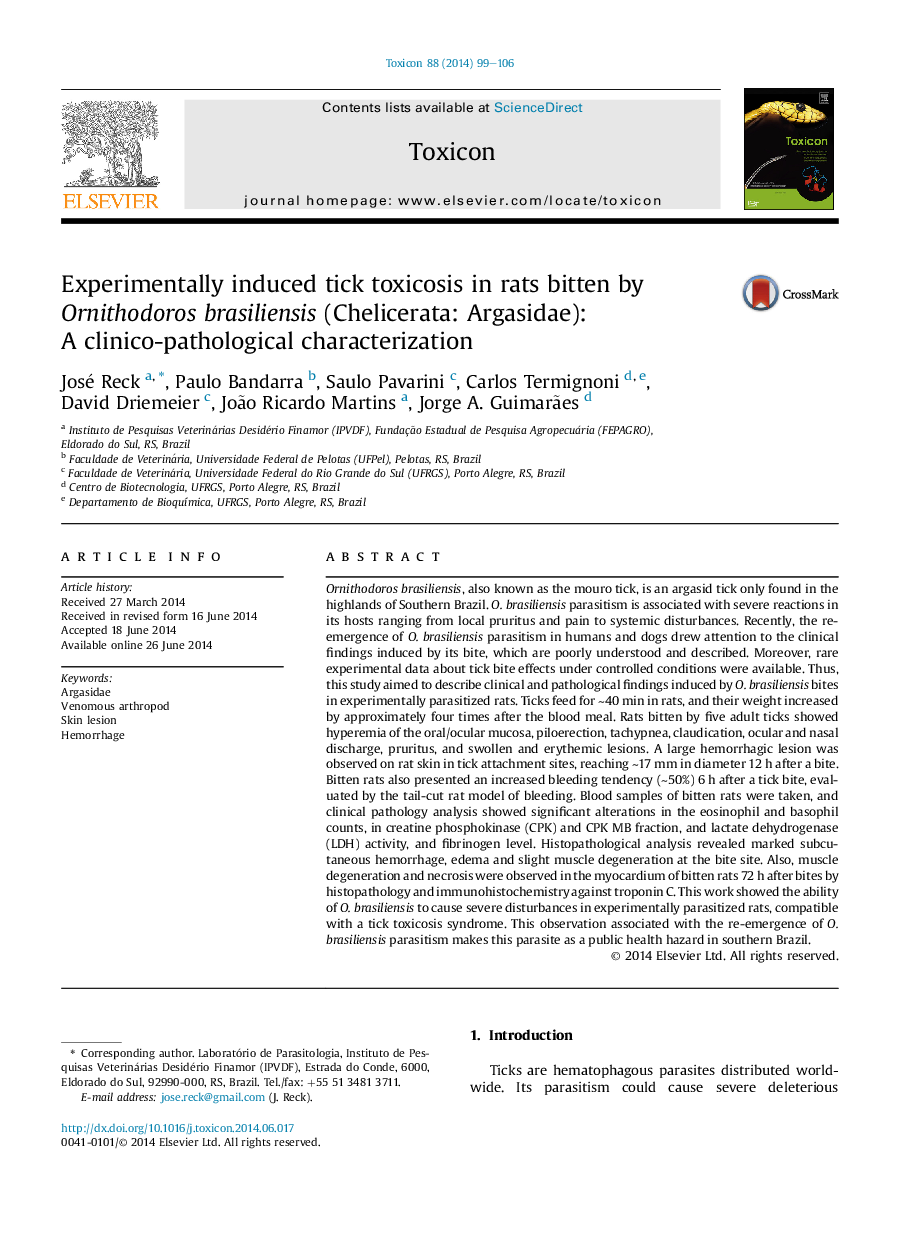| کد مقاله | کد نشریه | سال انتشار | مقاله انگلیسی | نسخه تمام متن |
|---|---|---|---|---|
| 8396340 | 1544147 | 2014 | 8 صفحه PDF | دانلود رایگان |
عنوان انگلیسی مقاله ISI
Experimentally induced tick toxicosis in rats bitten by Ornithodoros brasiliensis (Chelicerata: Argasidae): A clinico-pathological characterization
دانلود مقاله + سفارش ترجمه
دانلود مقاله ISI انگلیسی
رایگان برای ایرانیان
موضوعات مرتبط
علوم زیستی و بیوفناوری
بیوشیمی، ژنتیک و زیست شناسی مولکولی
بیوشیمی، ژنتیک و زیست شناسی مولکولی (عمومی)
پیش نمایش صفحه اول مقاله

چکیده انگلیسی
Ornithodoros brasiliensis, also known as the mouro tick, is an argasid tick only found in the highlands of Southern Brazil. O. brasiliensis parasitism is associated with severe reactions in its hosts ranging from local pruritus and pain to systemic disturbances. Recently, the re-emergence of O. brasiliensis parasitism in humans and dogs drew attention to the clinical findings induced by its bite, which are poorly understood and described. Moreover, rare experimental data about tick bite effects under controlled conditions were available. Thus, this study aimed to describe clinical and pathological findings induced by O. brasiliensis bites in experimentally parasitized rats. Ticks feed for â¼40Â min in rats, and their weight increased by approximately four times after the blood meal. Rats bitten by five adult ticks showed hyperemia of the oral/ocular mucosa, piloerection, tachypnea, claudication, ocular and nasal discharge, pruritus, and swollen and erythemic lesions. A large hemorrhagic lesion was observed on rat skin in tick attachment sites, reaching â¼17Â mm in diameter 12Â h after a bite. Bitten rats also presented an increased bleeding tendency (â¼50%) 6Â h after a tick bite, evaluated by the tail-cut rat model of bleeding. Blood samples of bitten rats were taken, and clinical pathology analysis showed significant alterations in the eosinophil and basophil counts, in creatine phosphokinase (CPK) and CPK MB fraction, and lactate dehydrogenase (LDH) activity, and fibrinogen level. Histopathological analysis revealed marked subcutaneous hemorrhage, edema and slight muscle degeneration at the bite site. Also, muscle degeneration and necrosis were observed in the myocardium of bitten rats 72Â h after bites by histopathology and immunohistochemistry against troponin C. This work showed the ability of O. brasiliensis to cause severe disturbances in experimentally parasitized rats, compatible with a tick toxicosis syndrome. This observation associated with the re-emergence of O. brasiliensis parasitism makes this parasite as a public health hazard in southern Brazil.
ناشر
Database: Elsevier - ScienceDirect (ساینس دایرکت)
Journal: Toxicon - Volume 88, 15 September 2014, Pages 99-106
Journal: Toxicon - Volume 88, 15 September 2014, Pages 99-106
نویسندگان
José Reck, Paulo Bandarra, Saulo Pavarini, Carlos Termignoni, David Driemeier, João Ricardo Martins, Jorge A. Guimarães,